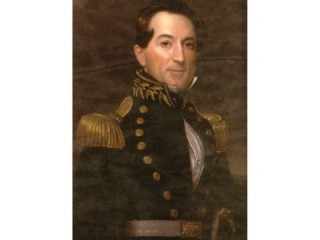
David Glasgow Farragut biography
Date of birth : 1801-07-05
Date of death : 1870-08-14
Birthplace : Knoxville, Tennessee, U.S.
Nationality : American
Category : Famous Figures
Last modified : 2011-02-11
Credited as : Naval officer, and admiral, European Squadron
The American naval officer David Glasgow Farragut was the hero of two of the most important Union naval victories in the Civil War. He became the first admiral in the U.S. Navy.
James (later David) G. Farragut was born on July 5, 1801, near Knoxville, Tenn., the son of George Farragut, a U.S. Army and Navy officer. After his mother's death in 1808, James was informally adopted by Commander David Porter, who had the boy appointed a midshipman 2 years later. Farragut changed his first name from James to David while sailing with Porter on the Essex during the War of 1812. Farragut brought a prize ship into Valparaiso, Chile, in 1813. The following year the British captured the Essex.
Farragut served in the Mediterranean (1815-1820) and temporarily commanded the brig Spark. After passing the midshipman's exam in 1821, he hunted pirates in the Caribbean (1822-1824) with Porter and for a short time commanded the schooner Ferret. On Sept. 2, 1824, he married Susan C. Marchant and in 1825 became a lieutenant.
From the 1820s to 1861 Farragut frequently served ashore at the Norfolk, Va., naval yard. In 1833 his ship was stationed off Charleston, S.C., during the Nullification Crisis. Promoted to commander in 1841, Farragut commanded the sloop Decatur on the Brazil station the next year. His first wife had died in 1840, and 3 years later he married Virginia D. Loyall, with whom he had one son. Farragut commanded the sloop Saratoga on blockade duty during the Mexican War. From 1854 to 1858 he supervised the construction of the naval yard at Mare Island, Calif. When Virginia seceded from the Union in 1861, he switched his permanent residence from Virginia to New York and offered his services to the North, but he remained under suspicion for months.
In January 1862 the Department of the Navy, convinced of his loyalty, made Farragut commander of the West Gulf Blockading Squadron. On April 24, after a 6-day bombardment, he ran past the forts below New Orleans with 17 ships and captured the South's largest port the next day. He continued up the Mississippi past the Vicksburg batteries on June 28 but could not capture the town. He passed the batteries again on July 14 in an unsuccessful effort to sink the Arkansas. Two days later he became the first rear admiral in the U.S. Navy.
In March 1863 Farragut led two ships past the batteries at Port Hudson on the Mississippi, but the fort surrendered in July only after a siege—several days after the Vicksburg victory. His next objective was the port of Mobile. On Aug. 5, 1864, under heavy fire, he sailed 18 ships between the Confederate forts at the heavily mined mouth of Mobile Bay. He captured the ironclad Tennessee following a fierce struggle inside the harbor and then received the surrender of the forts, thus sealing off the second-largest Confederate port on the Gulf of Mexico. That fall Farragut was relieved of command because of ill health. In December he received the new rank of vice-admiral. He became the first admiral of the U.S. Navy in 1866.
Farragut commanded the European squadron on a goodwill tour in 1867-1868. He died while visiting the Portsmouth, N.H., naval yard on Aug. 14, 1870.
















